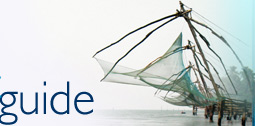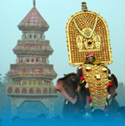Kerala Monument Architecture
The monuments of Kerala allow visitors to travel back in time to the exquisite palaces of the Kings and Queens of the bygone era. In the ancient times, Kerala had been a center of extreme political activity and because of its strategic location beside the Arabaian Sea, the land had witnessed the invasion of several foreign powers.
The Hill Palace Museum
The largest archaeological museum in Kerala, the Hill Palace Museum was the erstwhile official residence of the Kochi royal family. Built in 1865, the palace complex consists of 49 buildings in the traditional architectural style of Kerala, sprawled over 52 acres of beautifully landscaped terraced land which houses a deer park and facilities for horse riding.
Chinese Fishing Nets/Vasco da Gama Square
These huge cantilevered fishing nets are the legacy of one of the first visitors to the Malabar Coast. Erected in Fort Kochi between 1350 and 1450 AD by traders from the court of Kublai Khan, these nets are built of teak wood and bamboo poles. The best place to watch the nets being lowered into the sea and catch being brought in is the Vasco da Gama Square, a narrow promenade that runs along the beach. The square is an ideal place to idle, with stalls serving fresh delicious seafood and tender coconut.
Jewish Synagogue
In Fort Cochin, there stands the famous Jewish Synagogue built in 1568, and preserved till today. The population of the Jews has dropped drastically with the establishing of the Jewish State of Israel, many Jewish settlers in Cochin and other parts of Kerala left the country for Israel. There are only about 17 Jews left, and that the number of adult males does not come up to the required number for a Priest, the Community is without one. The Jewish Synagogue will be probably be taken over by a Trust, and because of it's historical importance to the history of Cochin (Kochi), will be preserved.
Bastion Bungalow
Built in the Indo-European style way back in 1667 AD by the Potuguese, Bastion Bungalow of Ernakulam get its name from its location on the site of the Stromberg Bastion of the old, Dutch fort. The building blends beautifully into the circular structure of the bastion, has a tiled roof and typical first floor verandah in wood, along its front portion. Though it has been said that a network of secret tunnels runs beneath the bungalow, none has been found till now. Today, the bungalow is the official residence of the Sub-Collector.
Bolghatty
A scenic island near the city of Ernakulam, Bolghatty is famous for the Bolghatty Palace built by the Dutch in 1744 AD. This palace was once a Governor's palace for the Dutch and later the home of the British Governors that has now been converted into a hotel. The palace is two-storeyed and contains well-decorated bedchambers and a huge lounge wherein historical portraits are displayed. The ferry ride from the mainland Ernakulam to the island is a pleasurable experience. There is a golf course to boot.
Koder House
Koder House, the magnificent building constructed by Samuel. S. Koder of the Cochin Electric Company in 1808 AD is a supreme example of transition from colonial to Indo-European architecture. Features like Veranda Seats at the entrance, floor tiles set in a chess board pattern, red colored brick like facade, carved wood furniture and a wooden bridge connecting to separate structure across the street are unique to this Bungalow.
Pierce Leslie Bungalow
The charming mansion was once the office of Pierce Leslie & Co., the famous coffee merchants. Founded in 1862 AD, this building, a representative of Fort Cochin Colonial Bungalow reflects Portuguese, Dutch and local influences. Characteristic features of this bungalow are wood panels that form the roof of ground floor, arched doorways, carved doors and sprawling rooms. Water front verandas are an added attraction to the magnificent house.
Residence Of Vasco Da Gama
Believed to have been the residence of Vasco da Gama, this is one of the oldest Portuguese residences in Fort Cochin. Built in the early 16th century, Vasco House sports the typical European glass paned windows and Balcony cum Verandas characteristic of the times.
Bishop's House
Built in 1506 as the residence of the Portuguese Governor, the Bishop's House stands on a little hillock near Parade Ground in Ernakulam. The facade of the house is characterized by large Gothic Arches and has a circular garden path, winding upto the main entrance. The building was acquired by Dome Jos Gomes Ferreira, the 27th Bishop of the Diocese of Cochin whose jurisdiction extended over Burma, Malaya and Ceylon in addition to India.
Chittur Gurumadam
Chittur Gurumadam, situated in Thekkegramam near Arikkode in Palakkad district, on the banks of the River Sokanasini, Chittur Gurumadam is a memorial to Thunchath Ezhuthachan, the author of 'Adhyatma Ramayana'. It is believed that the poet-saint spent his last days here. A 'srichakra', some of the idols worshipped by him, a stylus, wooden slippers and a few old manuscripts are exhibited here.
Gundert's Bungalow
Gundert's Bungalow at Nettur is on the outskirts of Thalaserry. It is a historically significant place for all lovers of Malayalam Language. Home of Dr. Hermann Gundert (1814-1893), a scholar of the German Basel Mission, who compiled the first Malayalam English dictionary, it is said that the revered German priest and lexicographer lived in the bungalow for 20 years from 1839. Mr. Gundert was the publisher of one of the Malayalam's oldest newspapers, the 'Paschimodayam', and also authored several books on Malayalam grammar.
This article is licensed under the GNU Free Documentation License. It uses material from the Wikipedia and numerous other sources that provide freedom to copy and redistribute content, with or without modifying it, either commercially or noncommercially. |







